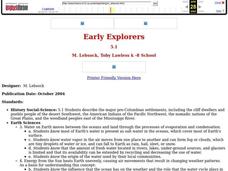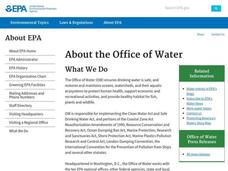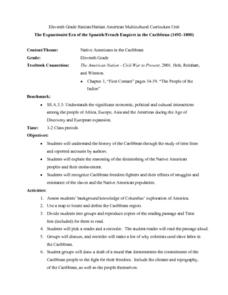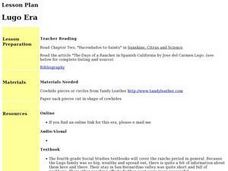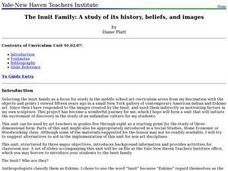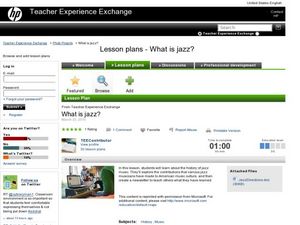Curated OER
Early Explorers
Fifth graders study early explorers. In this World history lesson, 5th graders draw an outline of a map labeling each part, build geographical features out of dough, and paint each of the land and water features.
Curated OER
Turning the Tide on Trash: Marine Debris Curriculum
Seven pages of fascinating reading on marine debris preface the activities in this lesson plan. Four different activities are employed to simulate how the debris is distributed in the ocean and along beaches. Early ecology learners...
Curated OER
The Witch of Goingsnake
Learners interpret a proverb and read examples of oral histories. In this The Witch of Goingsnake lesson, students read two samples of oral history and discuss quotations from each. Learners read "Calf Roper's Bandit Car" and...
Curated OER
The Future of Affirmative Action
Students act as a representative of a particular interested group before a Senate subcommittee which is charged to determine the future of federal affirmative action programs in this country.
Curated OER
What's in a Number? Analyzing Smoking Statistics
Sixth and seventh graders analyze smoking statistics. In this health lesson, learners look at the percentage of people who smoke from each race group. They create a bar graph and circle graph that displays this information.
Curated OER
Turning the Tide on Trash: Marine Debris Curriculum
Six different lessons comprise this unit on marine debris. Science, language arts, social studies, and art projects make this an ideal interdisciplinary unit. The result will be well-informed future citizens who can help make a...
Curated OER
It’s a Big, Big World
Students examine the role of the explorers. In this explorers and conquistadors, students create word puzzles (Wordles) regarding the time period in history. Students conduct research regarding a particular explorer and create foldables...
Curated OER
Ojibwa Sewn Bead Designs
Young scholars recognize and describe the sewn beading style of the Ojibwa tribe that was influenced by seventeenth-century French floral embroidery and fabric prints imported by the French traders. They adapt and recreate an Ojibwa bead...
Curated OER
Learning from the Past: A New Approach
Young scholars research nonprofit organizations. As they research, they learn how those living in the colonial period formed community organizations to provide for the common good of their society. Each pupil chooses one organization to...
Curated OER
Accordion Book for Comparing Cultures
Fourth graders are introduced to the different cultural groups that have settled in Ohio. In groups, they research and describe the products and cultural practices of each group. Using the information, they create an accordion book for...
Curated OER
The Edge of the Lake
Second graders explore the geography of Nevada. In this map-making instructional activity, 2nd graders use salt dough to create a relief map of Nevada. Students label the landforms and bodies of water that are studied and specified in...
Curated OER
Native People of the Caribbean
Eleventh graders use a map and locate and define the Caribbean region and then work in groups to read the passage and timeline. The groups' reader will read the passage aloud and the recorder makes a list of why colonists used slave...
Curated OER
Lugo Era
Fifth graders learn about the Lugo Era and how they lived by creating some materials that were used during that time. In this Lugo Era lesson, 5th graders use crafts to create items used during that era. They also learn songs and dances...
Curated OER
Navajo Code Talkers of WWII
Eighth graders assess different ways that significant individuals and events influenced economic, social and political systems in the United States after 1880. They experience a Navajo code talker's dictionary to create and decode messages.
Curated OER
Trailblazers - Now and Then
Students, working in pairs, use maps to determine the most efficient routes between two cities. They research which route would have been used by early trailblazers. They present a first person account of one of the trailblazers place in...
Curated OER
Pictograph Robe Stories
Fourth graders explore the diversity and commonality of human interdependence. Also, the global cooperation of the people of the United States and the world through a multicultural and historical perspective. They describe the...
Curated OER
Windows of Wisconsin (History)
Fourth graders research the history of Wisconsin. They explore Wisconsin's culture, sovereignty and environment. Using multiple computer technology resources (computer, scanner, camera, internet), 4th graders develop a book on the...
Curated OER
Understanding Agriculture as a Political Tool
Learners investigate how agriculture can be used as a political tool. They watch a PowerPoint presentation and take notes, identify reasons for protecting agriculture, write an essay about a current political issue in international...
Curated OER
Oklahoma Stone Soup
Class members complete activities related to the story "Oklahoma Stone Soup." First, pupils read, discuss, and answer questions about the story. Next, to incorporate math into the instructional activity, learners make stone soup using a...
Curated OER
Paving the Road to the Constitution
Eighth graders argue for or against the ratification of the U.S. Constitution. In this U.S. government lesson, 8th graders complete four activities that encourage them to examine the strengths and weaknesses of the Articles of...
Curated OER
Where Does Maple Syrup Come From?
In this maple syrup worksheet, students read an informational article about the discovery of maple syrup, how we get maple syrup today, the "sugar house", how to grade it, and a recipe for a snow cone. Students answer nine true and false...
Curated OER
The Inuit Family: A study of its history, beliefs, and images
Learners study the Inuit in terms of their geographic location and its influence on their way of life. They investigate Inuit imagery as a reflection of their belief system and focus on the objects of the Inuit to introduce...
Curated OER
Agriculture: Oklahoma's Legacy
Sixth graders explore agriculture as it relates to crops over the course of a series of historical events. They read and create a timeline of the 50-year increments that depict important cause and effect events. Students then use...
